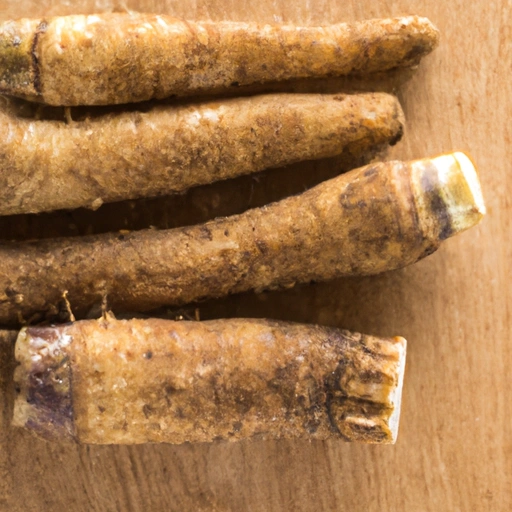Burdock
Description

Burdock is a root vegetable that's native to northern Asia and Europe. Known scientifically as Arctium lappa, it has a woody texture and is recognized for its earthy, slightly sweet flavor. The root is long and slender, resembling a stick, and has a rough, brownish skin with white flesh inside. It can grow up to about 1 meter (3 feet) in length and 2 centimeters (0.8 inches) in diameter. Burdock is often used in culinary applications, particularly in Asian dishes, and is also valued for its medicinal properties.
Common uses
Burdock root is commonly used in Asian cuisines, particularly in Japanese dishes such as kinpira gobo, where it's sautéed with soy sauce, sugar, mirin, and sesame oil. It's also a popular ingredient in herbal teas and can be consumed as a supplement in the form of capsules, extracts, or tinctures. Outside of Asia, it's often pickled or used in stews and soups.
Nutritional value
Calories
Per 100 grams, burdock root contains approximately 72 calories (302 kilojoules).
Protein
Burdock root provides about 1.53 grams of protein per 100 grams.
Fat
It is low in fat, with around 0.15 grams per 100 grams.
Carbohydrates
The root is rich in carbohydrates, offering about 17.34 grams per 100 grams.
Vitamins
Burdock is a good source of vitamins, especially vitamin B6 and folate.
Minerals
It is also rich in minerals like potassium, magnesium, and phosphorus.
Health benefits
Burdock root is believed to have diuretic and blood purifying effects. It is high in inulin, a prebiotic fiber that aids in digestion and gut health. Additionally, it has been associated with improved skin health and may have anti-inflammatory and antioxidant properties.
Potential risks
While burdock is generally considered safe for most people, it can cause allergic reactions in some individuals. It's also important for those with diabetes to monitor their blood sugar levels, as burdock can affect blood sugar control. Pregnant and breastfeeding women should consult a healthcare provider before using burdock supplements.
Common recipes
Burdock can be found in various recipes such as Japanese kinpira, Korean burdock salad, and European-style herbal teas. It can also be used in soups, stews, and as a roasted side dish.
Cooking methods
Common methods for preparing burdock include sautéing, boiling, roasting, and pickling. It can be eaten raw as well, thinly sliced or shredded into salads.
Pairing with other ingredients
Burdock pairs well with ingredients like carrots, soy sauce, sesame seeds, and meats like pork and chicken. Its earthy flavor complements sweet and savory dishes alike.
Summary
Burdock is a versatile root vegetable with a rich history in both culinary and medicinal contexts. It's prized for its earthy flavor and numerous health benefits. While it's a staple in Asian cuisine, burdock is gaining popularity around the world as a nutritious and flavorful ingredient.